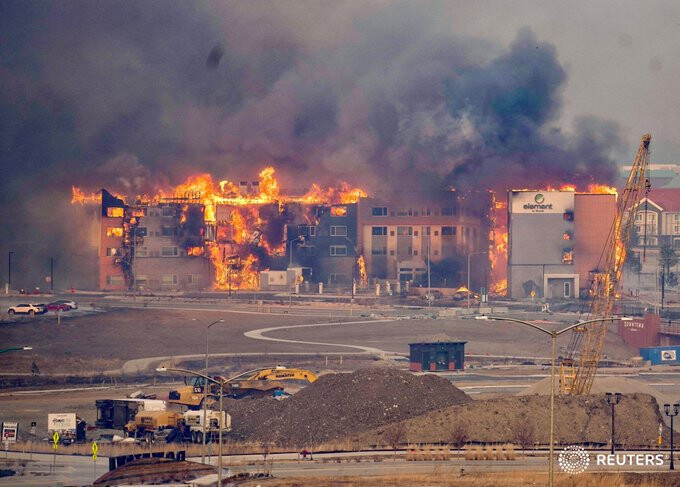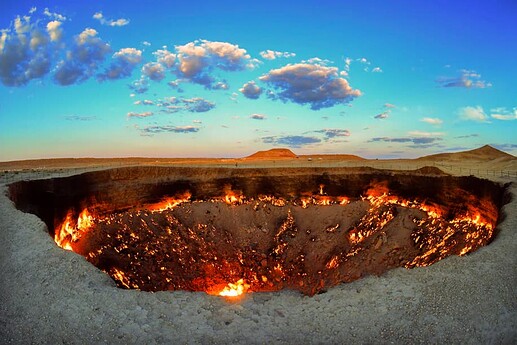This is fine:
Holy shit
Working hard! Thank you!

Entire hotel engulfed in flames
dumb opinion of the day. you see, fossil fuel vehicles are just better during extreme events, which are caused by over-use of fossil fuels.
A gas-powered Toyota RAV4, say, can go 440 miles between fill-ups, under ideal conditions; a fully charged Tesla Model X has a 351-mile range (and a much higher price). Of course, cold also affects the performance of gas-powered vehicles; many were left stranded in Virginia after they ran out of fuel or their batteries died.
All else being equal, though, cars and trucks with internal combustion engines (ICE) would have the advantage in coping with a sudden challenge such as the I-95 fiasco. It is much easier to rehabilitate a disabled ICE vehicle. Rescuers can deliver gallons of gas in convenient jugs; gas stations are still far more numerous than EV charging stations; and ICE car batteries can be jump-started in minutes.
Absent some breakthrough in mobile charging technology, out-of-juice EVs in out-of-the-way places will need a tow. If Monday’s nightmare had been an all-electric affair, they might have littered the highway for miles.
holy shit how have i not heard about this
https://www.washingtonpost.com/world/2022/01/08/turkmenistan-gates-hell/
If Turkmenistan’s president has his way, the “Gates of Hell” may soon be shut.
President Gurbanguly Berdymukhamedov said in televised remarks Saturday that he wants to extinguish the famous flaming natural gas crater that has burned in the Central Asian country for decades, Agence France-Presse reported.
The president raised environmental and economic concerns and asked his government to find ways to put the fire out.
The crater “negatively affects both the environment and the health of the people living nearby,” Berdymukhamedov said, according to AFP. “We are losing valuable natural resources for which we could get significant profits and use them for improving the well-being of our people.”
Officially called the Darvaza gas crater, the blazing pit in the middle of the Karakum desert has long been a draw for the few tourists permitted to visit Turkmenistan. About 200 feet wide by some measures and at least 70 feet deep, it cuts a dramatic image against the vast expanse of empty land surrounding it.
Good news doesn’t get any more in-your-face than this. One thousand fin whales, one of the world’s biggest animals, swimming in the same seas in which they were driven to near-extinction last century due to whaling. It’s like humans never happened.
Whales still face many threats, mostly from us. And we would do well to remember that the protests that saved the whales in the 1970s and 80s will be outlawed if the new police and crime bill passes into law. In a world constrained by woe and threats to democracy (it’s a good job whales don’t have to apply for the right to assemble), 1,000 fin whales can’t help but lift our hearts. They might even convince us that, as another species of (supposedly) sentient mammal, we still stand a chance of getting through “all of this”. So long as we stick together and send up a few protest spouts of our own.
This is like the only reason people go to Turkmenistan!
They’re probably just gathering around the watercooler to talk about the volcano eruption. “That was some wild shit, bro!”
Go for the Death Fire Hire, stay for the fermented camel’s milk!
i was hoping to read a better piece by a reasonable repub
but it turned out that he tries to take credit for 1m solar roofs which got accomplished 13 years and two governors after him. jlawok.gif
When I was California’s governor, we set a goal in 2006 of putting solar panels on one million roofs across the state. Skeptics said it couldn’t be done, but with bipartisan support in the State Legislature, California met its goal in 2019.
then he goes on to make things sound scary.
But it would also include a new monthly “grid participation charge” that would average an estimated $57 a month for solar customers. People who power their homes with fossil fuels wouldn’t pay this. So let’s call it what it is: a solar tax.
i get that the economics of energy is fucked up because the grid itself is a publicly-funded. i am sure the devil is in the details, right?
anyway, the rest of the piece is all about how the current plan is actually written by the industry and the evil democrats are obviously going to let them have it. it’s hard to understand because Arnold seems to criticize the plan and the utilities industry, but the utilities are apparently also critical of the plan.
yeah, anything that will cut solar adoption is bad, it’s not clear this will do that, or that $57 is fair, or if it will end up as that. perhaps @microbet can weigh in
Paywalled, but Arnold was very important for solar in CA. I started doing solar in 2007 right after the solar initiative he was part of making happen. In the following years the state and utility rebates have declined a lot, but prices have as well. The federal tax credit has been important, but Arnold did more for solar than any other governor.
And a $57/mo fee for only solar customers will seriously damage the residential solar market. It won’t matter as much to rich people with big electrical bills where that’s a relatively small percentage of their bill, but will kill the market to an increasing degree as you go to smaller houses and less rich people.
I loved that video - thank you for posting.
lower income and tribal solar are exempt from the grid participation fee. $57/month is an average and appears to be top heavy, basically whose time of use makes the bill high? anyways, it’s hard to generalize. thanks for the opinion
The question for solar adoption is how do you pay for the grid itself.
Grid costs reflect peak capacity. I.e. you need wires to your house thick enough to carry your greatest demand.
If a house uses solar. They might cut their usage in half but their peak demand will likely stay the same.
If you spread grid costs on a per Kwh basis, then you end up with non solar houses paying twice as much for the grid in comparison to a solar house.
On the surface it seems reasonable. But as it plays out, you end up with people in apartments and rentals paying more than people who own their own homes, so it’s pretty regressive and distributed wealth from the poor to the wealthier.
should the formula be some combination of total usage and peak? should apartments get some group rates?
That tends to be how business and commercial tariffs are set.
There are some efforts to put residential customers on the same tariffs. The challenge is that it’s really complex. Energy rates are confusing enough as it is. This makes it worse.
You have a customer that’s moving from one supplier to another and they want to know how much they are going to pay, or at least an estimate. Trying to work that out when it’s based on their peak usage in the upcoming month is very difficult, then explaining it to customers who tend to have minimal knowledge and even less interest… become even harder.
So generally. You have a bunch of energy nerds like me who sit and try and work out what the best and most equitable tariff scheme is. But it goes out the window for two reasons.
- What will customers be able to handle?
- What’s the political implications?
Solar customers tends to be middle class home owners who care a lot about solar rates specifically. They are solid voters with a clear and broadly aligned interest in policy.
The people on the other side of the equation tend to be less homogeneous and the link between solar policy and their interests is much less clear. Not to mention they might not be as reliable voters.
Increasingly this results in governments implementing sub optimal policy as a handout to a reliable voting block.
On balance tho, trying to make rooftop solar work might not be the ideal policy, but it beats governments implementing sub optimal policy as a handout to fossil fuel interests instead…
